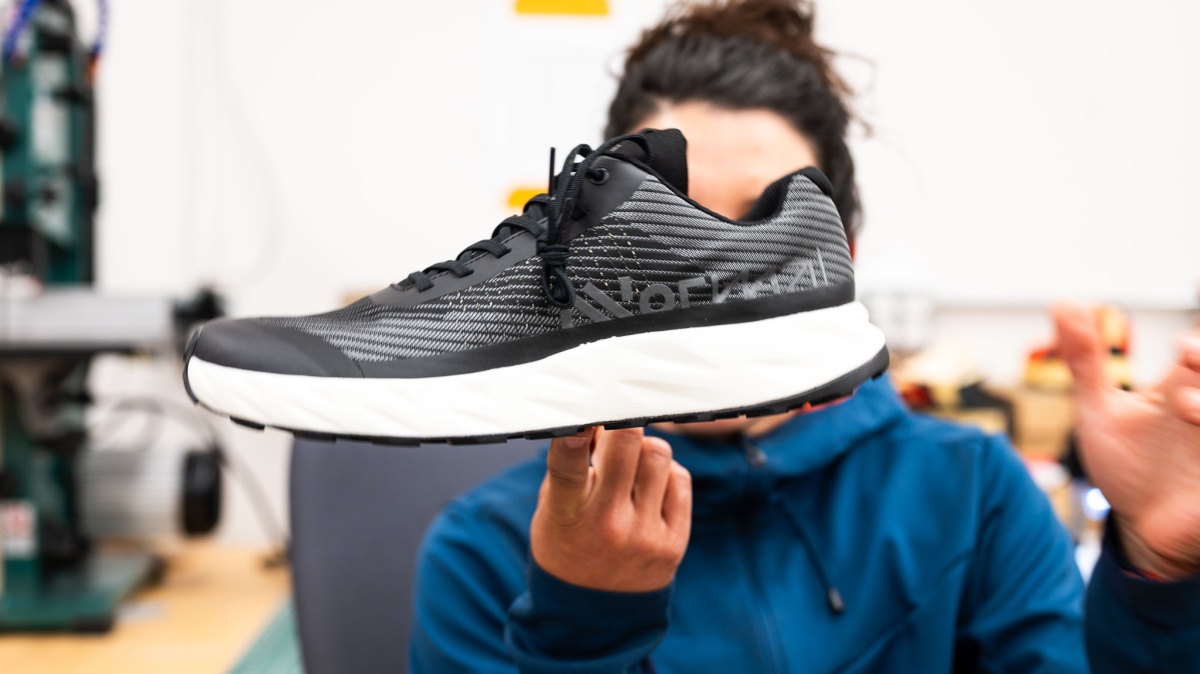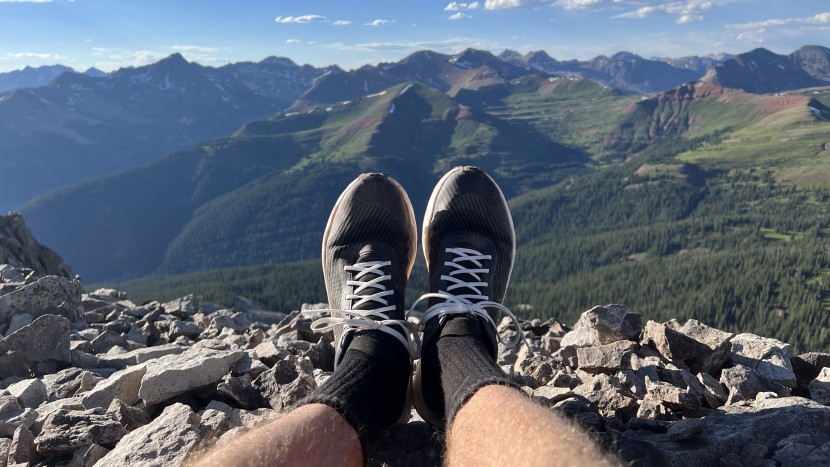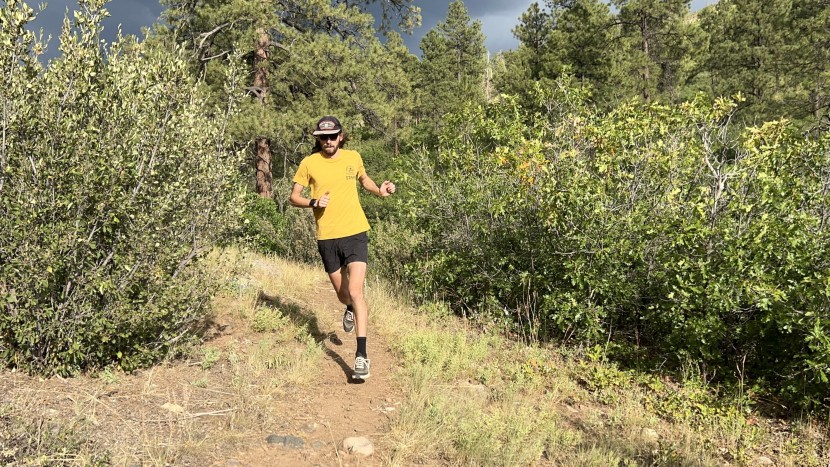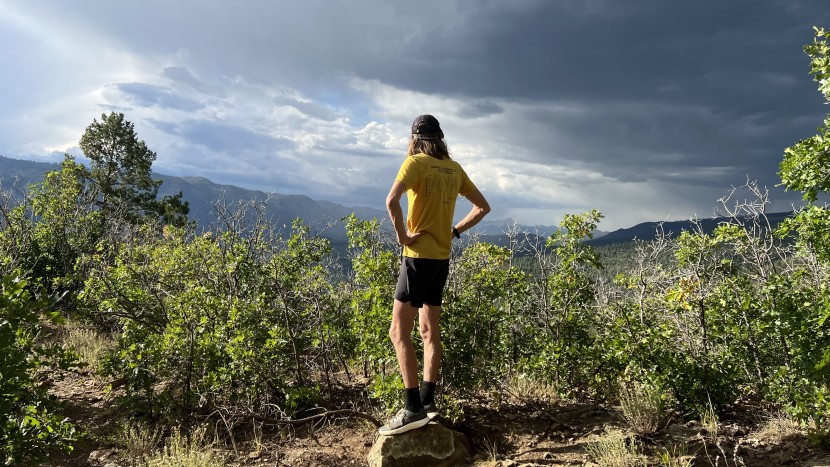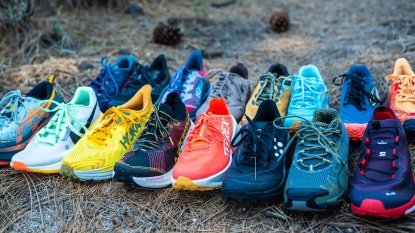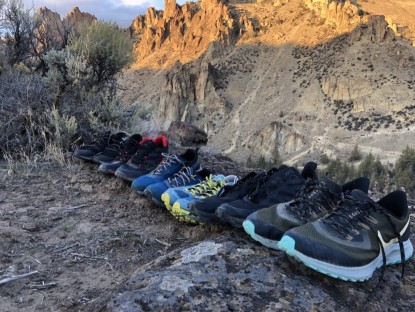
Our Verdict
Our Analysis and Test Results
Many of the popular shoes on the market today have a broken-in fit, which gives the user instant satisfaction. Midsoles feel bouncy, the upper padding is soft, and outsoles are softer, providing better traction. Unfortunately, this short-term comfort reduces long-term durability. When we first put on the Nnormal Kjerag, we were almost disappointed. The upper felt stiff, the laces didn't bite, the midsole felt hard, and the shoe felt like it had too much volume. But after running and sweating in the Kjerag we are happy to say all of our initial impressions have drastically changed for the better. This shoe is perfect for those who want an ultra-lightweight technical running shoe with subtle cushioning.
Comfort and Fit
At first, we found the upper platform to be tight in the midfoot, but after putting some miles in, our complaints subsided, and we find this a defining feature of the Kjerag. Your arches are supported, allowing the upper to have a more relaxed fit. This provides technical performance without the snugness of knit uppers. Once the upper got wet, sweaty, and dirty, the material broke in, conforming to our feet. There is no tongue padding, but the simple leather-esque material feels great and breaks in similarly to the rest of the shoe. We are big fans of the lack of insole, which prevents dirt and debris from hiding underneath the liner.
The EExpure midsole is where the Kjerag shines, offering subtle give with great energy return. Combine that with a crazy light design, and these are guaranteed to make your legs feel lively and fresh. The measured heel-toe drop of 8 mm (Nnormal claims 8 mm) is in our preferred range for pure running; this is supportive on the downhills but doesn't reduce liveliness on the uphills. Our lead tester prefers this model for his speed and high-tempo days more than any other in our lineup due to this blend of comfort and weight. That said, we'd have a hard time recommending it for anything over 50 miles due to the dense compound. If you are planning on doing long ultras (50+ miles), we'd reserve this shoe for the most competitive runners.
Stability
With a minimal stack and heel drop, this is one of the more stable shoes in our lineup. However, due to its slender nature and aggressive design, the Kjerag feels less stable than others that offer specific stability features.
A lot of the stability you feel (or don't) in this shoe will be derived from your muscles — so don't expect it to feel like a wide platform. This shoe's rubber is so stiff a lot of the stability is derived from the outsole. This, combined with the dense foam, makes the Kjerag feel stable on a wide variety of surfaces.
Traction
The Vibram Litebase outsole takes some getting used to due to the hardness of this particular rubber. Luckily, though, it breaks in over time. The benefit of hard rubber is that it's great in dry terrain. It runs excellently on hardpack and dry rocks, offering increased confidence on technical terrain. For scrambling or technical vertical terrain, you'll want something softer.
Another benefit of Vibram Litebase is dusty trails adhere less to the rubber, so when it is damp, you'll have less dirt/dust stuck to the bottom of your shoe. The downside is that in proper wet conditions, you have significantly less traction, and the already minimal lugs won't add much to the mix. Don't expect to use the Kjerag with much happiness in snow or mud.
The 3.0 mm lugs on the Kjerag fit perfectly with the style and weight class of the shoe but require constant forefoot pressure. More relaxed shoes with larger lugs require less forefoot pressure and can catch and propel you forward. If you aren't running on your forefoot, the Kjerag will not feel like it has good traction. As soon as you fatigue, you will start to slip as your weight shifts from your forefoot. This is another reason why this shoe is for advanced runners, especially if you plan to use it for long distances or technical terrain. It's important to keep in mind that body position and foot placement are the best solutions for dealing with traction, and the lugs come second. This doesn't mean there isn't a time and place for larger lugs, but with a shoe this lightweight, you should be able to feel comfortable on a variety of terrain types.
Foot Protection
The dense cushioning and hard Vibram Litebase on the Kjerag give decent underfoot protection. Upper protection is slightly lessened, given the minimal nature of the upper. Thin toe caps and slim heel protection give this shoe less protection than other models in our lineup. However, we tested the Kjerag on various sections of technical terrain and scree and found the protection to be adequate. This shoe excels at precise foot placement, so you shouldn't need much protection anyway. That said, for the most technical terrain, we'd still opt for a shoe that is more built.
The Kjerag feels lively but can beat you up if you are running more relaxed. It doesn't take heel strikes well, especially when running downhill. During our testing, when our legs felt flat, the Kjerag just felt too fast and dense. Due to this, we wouldn't recommend this compared to a more built all-day trainer. Given the price, this is a bit of a bummer, but we are still happy to recommend this shoe for the right user, given its seriously impressive durability.
Some folks may be wondering how the Kjerag compares to the Salomon S/Lab Ultra 3. We found the Ultra 3 to feel slightly more flat-footed, offering better side hill performance. The upper is also slightly more built, providing better protection on technical terrain, which comes with a weight penalty. While there are subtle differences elsewhere, this is where the determining factors between the two shoes lie. If you plan on only running, we'd recommend the Kjerag. If you plan on blending running and hiking on technical scree and talus, we'd recommend the Ultra 3.
Weight
This is the lightest pair of trail runners we've ever tested. Nnormal has created something that's incredibly fast but doesn't beat you up as much as you would expect. At a mere 8.05 ounces per shoe (US size 10.5M/11.5W), this is one of the lightest shoes on the market while still offering exceptional durability.
The upper is well made, and we had no signs of wear after many miles of use. This shoe will feel familiar to most runners who have tried lightweight designs in the past. But the compressive foam is more comfortable on longer distances than what we've experienced before. We have difficulty recommending this as a daily trainer due to how light it is. While the cushioning is great, there is a point where the minimal design does lead to fatigue and stress. We'd recommend pairing this model with something that offers more cushioning. Between those two, you should be set for almost anything.
Should You Buy the Nnormal Kjerag?
If you're an advanced runner looking to add a race/tempo shoe to your quiver, we don't think you'll be disappointed. While expensive, we are very impressed with the durability of this shoe thus far. We'd recommend supplementing the Kjerag with a heavier trainer for added cushioning on easy days. The ultralight design, while cushioned, does tend to beat you up if you aren't running with focused or fresh legs.
What Other Trail Running Shoes Should You Consider?
For a tighter-fitting upper and heavier design with similar technical performance, we'd recommend the Salomon S/Lab Ultra 3. While they are similar shoes, we find the Ultra 3 best for more extended time on technical terrain, whereas the Kjerag is best suited for fast running with technical terrain mixed in. If you plan on hiking technical peaks and ridgelines, you may find the Kjerag too light for your efforts. In this case check out the Norda 002 which offers a little more protection without sacrificing technicality or sensitivity.
| Awards | Best Trail Running Shoe with Ultralight Cushioning |
|---|---|
| Price | $195 List Check REI (on sale!) |
Overall Score  |
|
| Star Rating | |
| Bottom Line | For those that desire the lightest shoe in technical terrain, these are exceptionally comfortable and durable - perfect for racing or uptempo efforts |
| Pros | Ultralight, extremely durable, technical cushioning |
| Cons | Expensive, tight midfoot upper, longer break-in time |
| Rating Categories | Nnormal Kjerag |
| Comfort and Fit (40%) | |
| Stability (25%) | |
| Traction (15%) | |
| Foot Protection (15%) | |
| Weight (5%) | |
| Specifications | Nnormal Kjerag |
| Measured Heel Stack Height | 25 mm |
| Measured Heel-to-Toe Drop | 8 mm |
| Rock Plate | No |
| Measured Lug Depth | 3.0 mm |
| Measured Weight | 8.05 oz |
| Upper | Matryx Jacquard |
| Midsole | EExpure midsole |
| Outsole | Vibram Litebase Megagrip |
| Sizes Available | 4.5 - 13.5 US regular |
| Heel Tab Type | None |
| Claimed Heel-to-Toe Drop | 6 mm |


